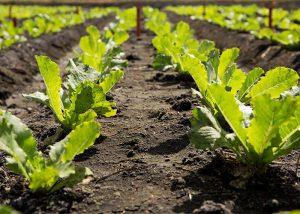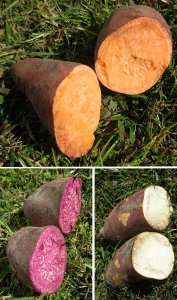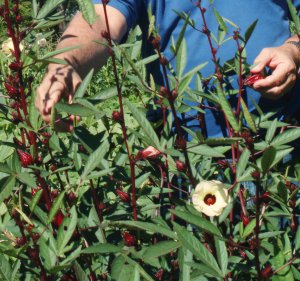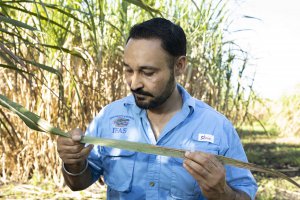Florida agriculture is much more than our hallmark citrus. Producers statewide grow some 300-odd commodities, from avocado to zucchini.
UF/IFAS researchers are continually exploring ways to help Florida farmers improve their crops, and Extension agents statewide are plugged in to support their success.
Here are some Florida-produced goodies that might be a tasty and creative addition to your Thanksgiving table.
A salad starter
Many meals begin with a good salad, and while Florida produces many of the fixings – carrots, peppers, all kinds of tomatoes, to name a few – lettuce is the core ingredient and also a Florida-grown specialty.

In Florida, more than 9,300 acres harvest lettuce throughout the state between September and May, with a majority of the production occurring in the Everglades Agricultural Area located just below Lake Okeechobee in Palm Beach County.
But the crop has had its challenges with the emergence of the Bacterial Leaf Spot (BLS), a disease caused by a pathogen known as Xanthomonas campestris pv. vitians (Xcv). This unpredictable disease can cause severe economic losses and has devastated entire harvests.
Scientists at Everglades Research and Education Center in Belle Glade, along with other land grant universities and federal agencies, have been at the forefront of research since the disease emerged. Focus has been on studying BLS and how it destroys lettuce. A $850,816 grant funds the continuation of research led by UF/IFAS scientists in a multistate endeavor to identify disease resistance, among other goals.
The aroma of Thanksgiving
Whether it is a dash, a pinch or a sprig, herbs like basil, parsley, rosemary and sage can help shape the flavor of every dish on a Thanksgiving spread.
Herbs are well suited for growing in Florida, both as a commercial crop and domestically in home landscapes and gardens, making them the perfect ingredients to enhance the flavors of the holiday. Herbs can be grown throughout the state, but commercial production is concentrated in the southern portion due to the benefit of higher year-round temperatures. There is also some production (field and greenhouse) in the northern part of the state.
Not just appealing to humans, though, the herbs are also vulnerable to pests and diseases. Scientists at Everglades Research and Education Center in Belle Glade have worked with commercial growers to contain downy mildew, a destructive disease that was first detected in south Florida in 2007. Thanks to the work of UF/IFAS researchers, growers can depend on plant management practices developed and updated regularly for sweet basil, parsley, rosemary, sage and other crops.
Mashed potatoes, sweet potatoes…even purple potatoes

Florida hosts 25,300 harvested acres of potatoes, with most acreage located in St. Johns, Flagler and Putnam counties, according to the 2019 USDA Census of Agriculture. At the UF/IFAS Hastings Agriculture Extension Center, researchers study which varieties of potatoes will perform best in the Florida heat and humidity. Often more than 20 different research trials are in place at one time. Last year, the team harvested 14,000 pounds from just 0.32 acres of potato study trials! All in an effort to provide farmers with the best potato variety to grow for your dinner plate.
UF/IFAS also planted its first organic sweet potato trial last year at the UF/IFAS Hastings Agriculture Extension Center. While Florida has a significant presence in the potato industry, sweet potatoes are not as commonly grown. Even more uncommon: One of the sweet potatoes tested is a purple variety known as the “Violet Queen.” Can you imagine a purple sweet potato casserole this Thanksgiving?
Rice, a global staple
With a unique versatility, rice holds a place throughout many countries and cultures, whether at the center of the plate, as a side or even as an ingredient in desserts.
Rice production in the Everglades Agriculture Area (EAA) of Florida dates back nearly seven decades. In 2018, a total of 24,986 acres of rice was planted in the EAA.
Entomologists at the UF/IFAS Everglades Research and Education Center in Belle Glade are focused on the pests that threaten this crop, such as the Mexican rice borer and three species of stink bugs.
With production steadily rising in the state, UF/IFAS faculty and Extension scientists also annually update Rice Production in Florida: A Handbook which serves as a resource for Florida producers, researchers, and the general public covering rice variety trials, water management, nutrients, pest and disease management, and information on related to post-harvest processing.
Pass the Florida Cranberry sauce

When Florida pioneers celebrated Thanksgiving, it is said that they used the roselle, a relative of the hibiscus plant, to create a cranberry-like sauce. This usage gave the plant its nickname, the Florida Cranberry.
The plant grows well in the Florida home garden, reaching a height of about 7 feet and producing yellow flowers in addition to the edible, dark red calyces. UF/IFAS Marion County Master Gardener Volunteers recently shared a few of their favorite recipes, but many options exist, from teas to jams to a substitute for rhubarb in pie.
Easy as (pumpkin) pie
Pumpkins come in many shapes, sizes and colors.
At the Tropical Research and Education Center (TREC) in Homestead, a researcher is investigating pumpkin varieties that will produce high-yielding, superior quality pumpkins that can withstand the hot, humid, and wet conditions of South Florida year-round. The cucurbit breeding program is led by Geoffrey Meru, an assistant professor of vegetable breeding, genetics and genomics. An additional component of his research focuses on the calabaza, which grows in tropical climates like in South Florida. Although not used for pies, it is a common ingredient in Latin American recipes.
Another “reliable” pumpkin for Florida gardens, according to the UF/IFAS Florida Master Gardener program, is the Seminole pumpkin. This squash can grow well in all regions of Florida, the program reports, and they even offer a recipe for a pie using this unique gourd.
Sugar – How sweet it is
While not the center of your Thanksgiving plate, this staple certainly has a place in many traditional Thanksgiving recipes: cranberry sauce, salad dressing, stuffing, pie.

Sugar comes from leaves of the sugarcane plant and is the most extensively grown row crop in Florida, with approximately 400,000 acres in the Everglades Agricultural Area (EAA). Florida is the top sugarcane producing state in the country, employing over 20,000 people and garnering a total economic value of over $3 billion.
The crop, however, is not immune to harsh weather, inconsistent soil conditions, pests and diseases. Scientists leading a development program at UF/IFAS Everglades Research and Education Center (EREC) in Belle Glade test varieties for yield, disease and pest resistance. The program has released 35 new cultivars in the last eight years.
And now, for a toast
With sparkling wines growing in popularity – the Beverage Information and Insights Group estimates a 56% sales increase in the category over a 10-year period – one UF/IFAS food scientist wondered if there was a better, cheaper way for Florida wineries to add carbonation without using the labor-intensive champagne method.
Andrew McIntosh, a UF/IFAS assistant professor of food science and human nutrition, is studying equipment options such as pressurized vessels, inline carbonation options and counter-pressure bottling equipment for various-sized wineries. McIntosh hopes his research will inspire more of Florida’s 43 wineries to add sparkling options to their product lines.
McIntosh’s early research has focused on the muscadine grape, the most common variety grown in Florida, with an estimated 1,500 planted acres (USDA 2017). However, he expects the method to work on wines with higher-than-average sugar concentrations.
 0
0
